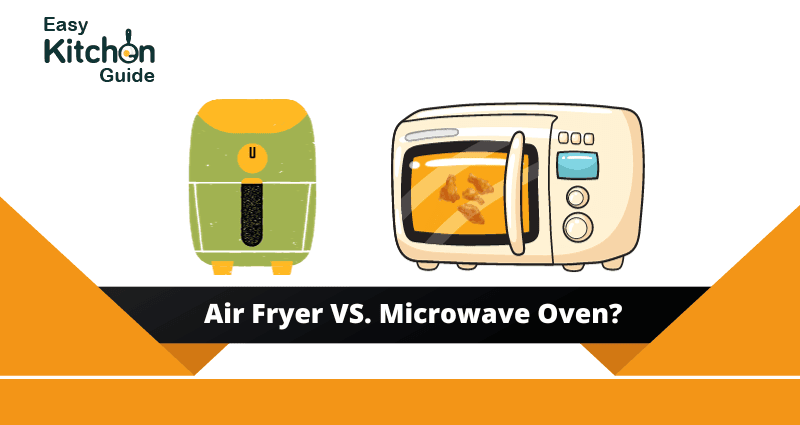In today’s fast-paced world, homeowners value appliances that make their cooking simpler and less time-consuming. Two such appliances, the microwave oven, and the air fryer, have become indispensable in many households. But can we use the microwave instead of the air fryer? In many households, both appliances coexist harmoniously, each serving a unique purpose. Microwaves excel in rapid heating and reheating, while air fryers offer versatility in cooking, baking, and achieving a crispy texture. The decision to use one over the other, or both, depends on your specific needs and cooking preferences.
In this blog post, we’ll explore the usage, cleanup methods, costs, and functionalities of microwaves and air fryers to help you determine if one can replace the other.
Microwave vs. Air Fryer: Usage Comparison
Table of Contents,
| Aspect | Microwave | Air Fryer |
| Heating | Rapidly reheats and evenly heats food and beverages. | Cooks, bakes, and reheats with convection and hot air. |
| Cooking | Suitable for pre-packaged meals, steaming, and defrosting. | Fries, bakes, roasts, grills, and dehydrates various dishes. |
| Reheating | Ideal for liquids and soft-textured leftovers. | Restores crispiness in fried and baked foods. |
| Defrosting | Quickly defrosts frozen food items. | Not typically used for defrosting. |
Can You Use an Air Fryer as a Microwave?
While an air fryer can reheat and cook a wide range of foods, it might not entirely replace a microwave’s convenience for heating liquids or quickly reheating food. Microwaves are still the first choice for these tasks because of their speed and efficiency.
In many kitchens, microwave ovens serve as a go-to appliance for tasks like reheating a cup of coffee, heating leftover soup, or defrosting frozen items. Its ability to quickly and efficiently generate heat with microwave radiation makes it perfect for these purposes. However, the microwave’s strengths lie in softening and heating food without preserving texture or crispiness.
Air fryers, known for their convection and hot air cooking methods, can indeed handle a wide range of tasks, including reheating and cooking. They offer several benefits, such as:
- Crispiness Preservation: Air fryers can reheat and cook foods while maintaining their crispiness. If you’re a fan of crispy leftover pizza, fried chicken, or other fried and baked foods, the air fryer can restore their texture effectively.
- Versatility: Air fryers are versatile kitchen appliances. They can fry, bake, roast, grill, and even dehydrate, expanding the range of dishes you can prepare.
- Restaurant-Quality Results: If you aim to achieve restaurant-quality results at home, an air fryer can be a valuable addition to your kitchen.
Air fryers can handle many cooking and reheating tasks, but they may not be a one-size-fits-all replacement for the trusty microwave. Microwaves are unparalleled for rapidly heating liquids like coffee, tea, or soup. Their efficiency in reheating soft-textured leftovers such as pasta, rice dishes, or stews is hard to match, and they are highly effective at defrosting frozen food rapidly.
Microwave vs. Air Fryer: Cleanup Comparison
One significant aspect of choosing kitchen appliances is considering the ease of cleaning and maintenance. The last thing anyone wants is a kitchen appliance that becomes a chore to clean after use. Both microwaves and air fryers have their own set of cleaning requirements, which can influence your decision to purchase either of them. Now, let’s delve into the specific cleanup methods for each appliance in the comparison:
Microwave Cleaning:
Cleaning a microwave is a straightforward process. Here’s how it can be done:
- Wipe Down Interior: After use, wipe down the interior with a damp cloth or sponge. Ovens are designed to have smooth surfaces that are easy to clean.
- Remove Turntable: Most microwaves have a removable turntable. Take it out, and you can clean it separately, either by hand or in the dishwasher.
- Deodorize: To remove any lingering odors, you can place a bowl of water with a slice of lemon or a tablespoon of vinegar inside the microwave. Run the microwave for a few minutes, and this will help freshen the interior.
Microwave ovens typically need low maintenance and require minimal effort to keep clean.
Air Fryer Cleaning:
Cleaning an air fryer may take a bit more effort due to the nature of the cooking process. Here’s what the cleaning process looks like:
- Empty the Basket: Start by removing any remaining food particles from the air fryer basket. This step is crucial to ensure optimal air circulation during cooking.
- Soak and Scrub: To address any residue or stubborn food particles, you can soak the basket and tray in warm, soapy water. After soaking, scrub them to remove any leftover grime.
- Wipe Down: Wipe both the interior and exterior of the air fryer with a damp cloth. Keep focus on the heating element and make sure it’s clean and free from grease or food.
Aspect | Microwave | Air Fryer |
| Cleaning | Empty the basket, soak and scrub, and wipe down the interior and exterior. | It may require more regular maintenance. |
| Maintenance | Requires less frequent cleaning. | Empty the basket, soak and scrub, wipe down the interior and exterior. |
| Effort | Relatively simple and quick. | Requires a bit more effort. |
While air fryers require a bit more attention to clean, the process isn’t overly complicated. The advantage of an air fryer is that it can cook with less oil, which means less oil residue to deal with in the cleaning process.
Cost Considerations
In the ongoing debate between microwaves and air fryers, another critical consideration is the financial aspect. When deciding between these kitchen appliances, it’s essential to weigh the costs associated with each, both in terms of initial investment and long-term expenses. Understanding the financial implications can help you make a well-informed choice that aligns with your budget and kitchen needs. Let’s delve into the details of which appliance offers a more cost-effective solution. When comparing the costs of a microwave and an air fryer, consider the following factors:
- Initial Investment: Microwaves are typically less expensive than air fryers, making them a budget-friendly choice.
- Energy Consumption: Air fryers are energy-efficient because of their shorter cooking times, which can lead to lower electricity bills in the long run.
- Food Quality: While air fryers might cost more initially, they can save you money by allowing you to prepare restaurant-quality dishes at home, reducing the need to dine out.
- Maintenance: Microwaves usually require less maintenance and have a longer lifespan, while air fryers may need more frequent cleaning and maintenance.
The cost-effectiveness of these appliances depends on your cooking habits, the quality of food you want to achieve, and your long-term energy consumption.
Microwave vs. Air Fryer: Functionalities
One of the key factors to consider when choosing kitchen appliances is their functionality. The features and capabilities of an appliance can influence its usefulness and versatility in your daily cooking routines. Let’s compare the functionalities of microwaves and air fryers:
Microwave
Microwaves are famous for their versatility. They can:
- Quickly heat or reheat food.
- Cook pre-packaged microwaveable meals.
- Defrost frozen items.
- Steam vegetables when using a microwave-safe container.
Air Fryer
Air fryers are known for their ability to:
- Fry foods without deep-frying, reducing oil consumption.
- Bake a variety of dishes, from pastries to pizza.
- Reheat leftovers while retaining their crispiness.
- Roast, grill, and dehydrated foods.
While microwaves are versatile, air fryers offer an additional level of versatility due to their ability to cook, bake, and fry with excellent results.
Reheating Food
Reheating food is a common kitchen task that many of us perform on a daily basis. Whether it’s leftovers from last night’s dinner or a quick warm-up of your morning coffee, the efficiency and quality of reheating can significantly impact your meal experience. Let’s explore how microwaves and air fryers stack up when it comes to reheating your favorite dishes.
Microwave:
Reheating food in a microwave is fast and convenient. It’s suitable for:
- Liquids: Quickly heating beverages like coffee, tea, or soup.
- Leftovers: Reheating meals like pasta, rice dishes, and stews.
- Baked Goods: Softening and warming bread, rolls, and pastries.
Air Fryer:
Reheating food in an air fryer offers unique advantages:
- Crispy Texture: It can restore the crispy texture of fried and baked items.
- Reduced Sogginess: Leftovers are less likely to become soggy.
- Versatility: You can reheat a wide range of foods, including pizza, fries, and fried chicken.
While microwaves are unbeatable in speed, air fryers provide superior results for reheating items you want to remain crispy.
Microwave vs. Air Fryer: Ideal For Cooking
When we buy an appliance, what purpose does each appliance serve for cooking? Understanding the working can help us make an informed decision that aligns with our culinary preferences and the dishes we love to cook. Let’s dive into how microwaves and air fryers differ in cooking methods.
Microwave
Microwaves are ideal for:
- Quick heating and reheating.
- Steaming vegetables.
- Cooking pre-packaged microwaveable meals.
However, they are less suitable for recipes that require a crispy or baked texture.
Air Fryer
Air fryers are excellent for:
- Frying without deep-frying leads to a crispy texture.
- Baking various dishes like cookies, pastries, and pizza.
- Roasting, grilling, and dehydrating foods.
Air fryers provide more cooking versatility compared to microwaves and are perfect for achieving that crispy texture in a wide range of dishes.
When to Use an Air Fryer and a Microwave
The decision to replace a microwave with an air fryer or vice versa depends on your cooking habits and requirements. Here’s when each appliance shines:
Use an Air Fryer:
- When you want to cook or reheat fried foods while maintaining their crispiness.
- For baking items like cookies, pastries, or pizza.
- To roast, grill, or dehydrate foods.
- If you prefer restaurant-quality results at home.
Use a Microwave:
- When you need to heat quickly or reheat liquids, such as coffee, tea, or soup.
- For reheating soft-textured leftovers like pasta, rice dishes, or stews.
- To defrost frozen food rapidly.
In the eternal battle of microwave vs. air fryer, there’s no clear winner. The best kitchen setup involves having both a microwave and an air fryer, allowing you to harness the benefits of each appliance and enjoy a wide range of culinary possibilities. So, while you can use an air fryer for many cooking tasks, it may not entirely replace the trusty microwave in your kitchen.







